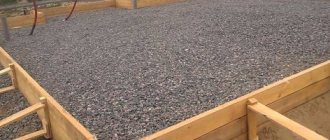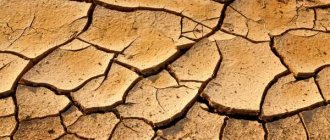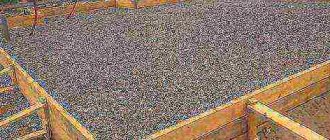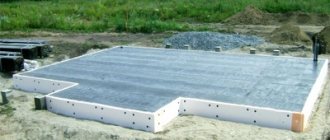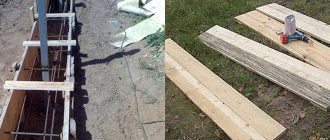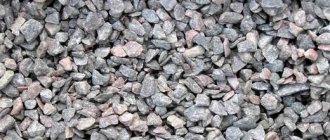Different foundations are laid for different structures. The foundation is the basis of the future structure; the service life of the entire structure depends on its design features. However, this basis also requires its own sub-foundation. The integrity of the foundation of the future house depends on the type of soil on which it is placed. Both in the case when there are strong stable soils under the future building, and when there are loams under the house, a cushion for the foundation is organized.
It is recommended to lay it under any foundation, regardless of its size and depth. It is very important to select your own sub-base for a specific type of foundation so that it fully fulfills the tasks assigned to it.
Pillow under the stove
Why do you need a pillow under the foundation?
A foundation cushion is an artificial foundation made of gravel, sand, concrete, reinforced concrete blocks, which is not part of the foundation structure, but replaces part of the soil underneath it. The pillow performs a number of functions.
Table 1. Functions performed by the foundation cushion.
| Function performed | Description |
| Alignment | Should level the bottom of the trench. It is necessary to construct a substructure for prefabricated and slab foundations. When laying a shallow belt under low buildings, a layer of gravel or even compacted sand performs this function |
| Protection against ground movements | Protects the foundation from seasonal soil movements. When pouring a layer of sand or gravel onto weak and heaving soils, the bearing capacity of the soil increases, which ensures a reliable foundation |
| Drainage | Prevents moisture from rising from the soil into the foundation and drains rainwater to the side |
| Frost heave protection | Preventing the foundation from being pushed out of the ground by expanding water |
| Reducing building shrinkage processes | Creates a stronger support under the object |
| Increasing the stability of the structure | Especially appreciated in seismologically troubled areas |
Separately, I would like to focus attention on the phenomenon of frost heaving , which is protected from by a sub-base that is denser than soil. This phenomenon is especially typical for clay soils . Clay soils freeze unevenly in winter, increasing in volume by up to 9% .
Moreover, throughout the winter, clay sucks up moisture from the lower horizons of the soil, increasing in volume even more. Moreover, if the groundwater level is high, then the clay can swell up to tens of centimeters and lift a house, a road and even a railway track. As a result of this effect of frost heaving, the foundation can easily crack in the spring. A base made of coarse sand, crushed stone or sand-gravel mixture, which performs a shock-absorbing and drainage function, will save you from the effects of destructive forces.
The effect of frost heaving
Which is better sand or crushed stone
The requirements for preparing the foundation pit for the foundation require strict instructions in the construction project based on an analysis of the bearing capacity and properties of the parent soil.
The best preparation for a strip foundation or monolithic slab is lean concrete, and only in some cases is it possible to replace concrete with sand, gravel or ASG to reduce overall costs. At the same time, sand has a wide range of advantages and is more practical.
Gravel is suitable only in cases where high throughput is required when it is necessary to arrange a drainage layer with low water capacity. At the same time, it is difficult to isolate the bedding from the volume in which the foundation will be poured.
The gravel backfill goes well with pile foundations, where it is enough to remove excess moisture from under the foundation of the house, and at the same time there will not be a significant load on the backfill itself.
Under strip foundation
By definition, sand bedding is needed only when ready-made reinforced concrete slabs and blocks are used in order to distribute the load evenly along the base plane.
With the help of sand it is easier to level the bottom of the pit, and tamping gives the sand the necessary density and load-bearing capacity.
However, this is only relevant if it is possible to place a massive vibrating plate in the trench for mechanical compaction of sand. In most cases, it is safer to use a lean concrete footing to level the base and prepare it.
Sand is also relevant in case of significant differences in height along the bottom of the prepared trench. To reduce costs and reduce the volume of solution for the concrete base, sand or crushed stone is added with layer-by-layer compaction and moistening.
Under a monolithic slab
It is important to strictly level the base of the pit and prepare the soil for installation of the reinforcing frame and pouring. Either lean concrete or sand compacted in layers is used.
stages of construction of a monolithic foundation
Sand is mainly used in cases where it is necessary to significantly raise the bottom of the foundation pit after removing the entire fertile soil layer to the base of the parent soil.
When forming the bedding, it is important to pre-distribute trays for water drainage, communication lines that will pass through the foundation slab, and also mark the required planes of the future foundation. According to the requirements, a base is formed under the monolithic slab not strictly in one plane, but with a slight elevation in the center of the building and with a slope of 2-3% in all directions, for effective removal of moisture from the substrate of the future foundation
According to the requirements, a base is formed under the monolithic slab not strictly in one plane, but with a slight elevation in the center of the building and with a slope of 2-3% in all directions, for effective removal of moisture from the substrate of the future foundation.
Particular attention is paid to the quality of sand compaction. Thus, the density of the backfill for the foundation should be from 1.65 t/m3 and preferably not less than the density of the parent soil with an error within 0.05 t/m3
The height of the backfill is determined as the difference between the level of the bare base of the soil after removal of the fertile layer and the design level of the foundation base.
Under a pile foundation
The backfill primarily performs the function of drainage to drain groundwater, and also acts as a substitute for the fertile layer of soil in order to remove the volume of material containing organic or combustible inclusions from under the foundation.
backfill device for pile foundation
For these purposes, it is best to use large and medium gravel and crushed stone. Expanded clay bedding is often used, which further increases the thermal insulation properties of the base.
Types of pillows for the foundation
Let's look at the main types of foundation pillows.
sand cushion
A sand cushion is a very common type of base for tape, especially for one-story buildings due to the availability and low cost of the building material. For its construction, coarse-grained river or quarry sand is taken. When calculating the volume of building material, you need to add approximately 15% for compaction. Sand has its advantages:
- drains rain well;
- absorbs groundwater;
- acts as a shock absorber during heaving;
- increases the thermal insulation properties of the structure;
- compacts well.
Benefits of a sand cushion
The sand base is most often chosen in the following cases:
- for light and one-story buildings: houses, garages, outbuildings;
- when it is necessary to replace loose soil under the foundation with more compacted one;
- under shallow foundations to cut off capillary suction.
The dimensions and thickness of the sand base are selected based on the type of soil, number of floors and building material, and soil characteristics. The thickness of the sand base under the tape depends on its width. 15 cm thick is poured under the slab 30 cm thick under piles and pillars , in addition it should be wider than the size of the pillars by 15-20 cm in circumference. On clay soils, the thickness of the cushion can reach half a meter . In this case, sand is poured in layers of 15-20 cm and each layer is spilled and compacted.
Advice! Experts do not recommend making a very thick base, since it is difficult to predict how it will behave in extreme conditions.
sand cushion
In addition, to install a high-quality sub-base in a place with high groundwater level, you will need waterproofing material , for example, geotextiles or roofing felt. The fact is that sand absorbs water very well, which, without waterproofing, will rise through the pores of the foundation concrete up into the walls. Geotextiles are laid both under the sand layer and on top. The layers laid on it are pre-compacted with a tamper. For better compaction, it is better to water the sand.
Gravel bed
The crushed stone cushion is also very popular due to its simple backfill technology and greater strength than sand. Crushed stone for these purposes can be taken of two types: gravel and granite. Limestone is not suitable for such tasks due to its low quality .
Gravel is a type of crushed stone obtained by sifting quarry or river sand. Crushed gravel is used in 90% of cases for backfilling the foundation. It has a more affordable price compared to granite. Crushed gravel has a rounded grain shape.
Gravel absorbs less water than sand and can withstand greater loads . Thanks to this feature, the crushed stone cushion can serve as a base for the foundation of two- and even three-story buildings. In terms of cost, this option will be more expensive than sand backfill.
Prices for granite crushed stone
Crushed granite
Video - How to compact crushed stone
To make the pillow, a crushed stone fraction of 20-40 mm with a strength of M1200 . This is a frost-resistant building material, which is especially important. Crushed stone is poured onto a sand bedding and compacted. If a thick layer of gravel is needed, then it is poured and compacted, like sand, layer by layer. Liquid bitumen compounds are used as waterproofing , since rolled and fabric materials can be damaged by the sharp edges of crushed stone.
Note! A number of experts believe that the use of waterproofing is not justified and can only lead to higher construction costs at low groundwater levels.
Experience is used to justify the method. If you take 2 glass containers and fill one third with water, and then carefully pour sand into one, and gravel into the second, then the humidity in the sand will rise much higher than the water level, while in the container with gravel it will remain in the same place. This is because gravel does not absorb water as much as sand.
Combined sand and gravel cushion - step-by-step installation instructions
Quite often, builders fill in a combined bed of sand and crushed stone. The requirements for building materials remain the same: coarse river or quarry sand without clay admixtures and gravel 20-40 mm . Building materials are poured in layers in the form of a pie in the following order:
Step 1. Geotextile is laid on the ground with a margin around the edges to wrap the ends of the sand layer.
Sand is laid on geotextiles
Step 2. The sand layer is compacted.
Compacting the sand layer
Step 3. A layer of sand is covered with geotextile on top.
The compacted layer of sand is covered with geotextiles
Step 4. Another thin layer of sand is poured onto the geotextile to avoid damage to the fabric waterproofing by the sharp edges of the gravel.
A small layer of sand is poured on top of the geotextile
Step 5. 10-20 cm of crushed stone, which is compacted up to 5-6 times . The cake is spilled with water and compacted.
Compacting crushed stone
This sand-crushed stone base is perfect for weak-bearing soils. It should be borne in mind that sand and gravel pillows themselves are subject to slight shrinkage . Therefore, special attention must be paid to compaction.
Prices for various types of geotextiles
Geotextiles
Concrete pad for foundation
Concrete base is rarely used in private housing construction due to its high cost and labor-intensive pouring. However, it is she who has the greatest strength among all those presented. The concrete base is made in the same way as the foundation design, only thinner. In general, filling can be divided into the following stages:
- excavation;
- installation of sand bedding, its compaction;
- waterproofing device;
- pouring a thin layer of concrete;
- erection of formwork;
- installation of a horizontal reinforcing layer;
- pouring concrete;
- bayonet;
- drying period.
Concrete pillow
This way you get the strongest pillows for the foundation.
Prices for different types of cement
Cement
Reinforced concrete pad for the foundation
A support option for prefabricated foundations is special ready-made trapezoidal products. Inside them there is a steel reinforcement frame. It is the foundation pads that are used for the construction of large buildings.
They are designed as a support for ready-made foundation blocks. On the top of the product there are eye loops designed for easy gripping by a crane. Additional products are produced for the main blocks . Advantages of reinforced concrete pads: versatility , durability and quick installation . The disadvantages include the need to use special equipment to work with them.
In private housing construction, blocks are used for the construction of manor-type houses, as well as for the construction of luxury houses. Before starting work on their installation, the bottom of the pit or trench is leveled or compacted. On unstable soils, a sand base can be used for leveling purposes.
On the leveled and compacted bottom, blocks are placed end to end so that a line is formed. The resulting sinuses are sealed with cement-sand mortar. Concrete foundation blocks with bandaging are installed on the upper plane.
Blocks for the foundation
Prices for various types of foundation blocks
Foundation block
Laying the reinforcement cage
When the formwork is ready, concrete mortar is poured into it. When deciding how to make a concrete pad for the foundation, we must not forget about the reinforcement cage, which helps increase the strength of the cushion. When the concrete is completely poured into the formwork to the required level, two rows of steel rods are laid along the entire perimeter of the base pad.
The reinforcement is laid on top of the still wet concrete that has not had time to set at a distance of 15 cm from the formwork walls. Next, they need to be sunk into the concrete solution to a depth of about 20 cm. In order not to leave air bubbles in the solution that were formed as a result of immersion of the rods, the concrete is carefully bayoneted.
At the last stage of installing a concrete pad, it is necessary to carefully level the surface using tools. The surface of the base is then rubbed. This ensures that all dust and dirt after removing the formwork are removed from the surface of the cushion easily and simply.
Most often, the adhesion of the sole and the foundation is achieved through reinforcement bars, which are left in a vertical position to a height equal to the height of the foundation itself.
Before dismantling the formwork, it is advisable to mark the position of each corner of the future base on the upper edge of the cushion. This will be a guide when it is necessary to install the formwork for the construction of the foundation itself.
Installation of a pillow under the foundation
Unlike sand and gravel pads, in many cases concrete pads are an extension of the foundation. Widening is necessary when the width of the foundation wall is clearly not enough to support the weight of the house being built. The widening is performed as an armored belt under the foundation wall or as a shoe under a pillar.
Pillow device
Such concrete widening is necessary to increase the area of the base on which the structure will rest with all its weight. The larger the area, the more weight the base can support.
As for the dimensions, the thickness of such a widening should be at least 300 mm , but not more than 400 mm .
How to arrange such a pillow:
- The ground is backfilled with sand or gravel in a layer of 150-200 mm and compacted .
- Formwork is being made . When making the tape, you can do without it.
- Waterproofing is carried out : the crushed stone base is poured with hot bitumen . However, if you add Penetron Admix to the concrete, waterproofing is not needed. However, you should lay a layer of thick construction polyethylene (or 2 if the base was gravel) so that water does not escape from the concrete.
- Reinforcement is carried out : it is carried out by connected meshes of rods with a diameter of at least 12 mm . 70mm from the bottom 30-40mm from the top .
- Concreting is carried out : concrete is poured into the formwork, compacted, and leveled. It is better to pour concrete once to avoid the formation of seams. Otherwise, vertical cuts must be made. The surface is covered with polyethylene to ensure high humidity of the concrete during hardening.
- The formwork can be removed on the third day. The hardening time of the pillow is 28 days .
Determining the thickness of a monolithic slab
The thickness of the monolithic reinforced concrete slab, which will be the foundation of your future building, is determined based on the characteristics of the soil of your site. Different soils can support different maximum loads.
The total load on the ground is thus determined from the following initial data:
- The weight of the foundation reinforced concrete slab itself,
- Weights of all building materials that will be used to construct your structure
- A payload that will weigh down your structure. This load includes furniture and various infrastructure.
- Temporary seasonal and climatic loads. It is necessary to take into account the weight of possible snow cover and possible wind pressure.
Practice shows that for light utility and domestic buildings, for example, garages or sheds, it is sufficient to create a foundation slab 10 centimeters thick. To build residential buildings, the thickness of the foundation base is increased to 25 centimeters. This thickness allows for full-fledged multilayer reinforcement.
Pillow under the ribbon
Today you can find a huge selection of ready-made reinforced concrete foundation pads on sale. Structurally, they are trapezoidal products made of heavy concrete reinforced with a mesh frame. Such blocks optimize the load on the bottom of the foundation and reduce the pressure of the building on the ground.
In addition, the installation of ready-made blocks reduces labor costs during construction. The foundation pads are placed on a sand bedding and connected with cement mortar. Subsequently, foundation blocks are installed on them.
Foundation pad
Experts advise placing a pillow under any tape, regardless of its size and depth. Any sub-base can be laid under the tape: concrete, reinforced concrete, sand, gravel, combined. What specific material can be used depends only on the properties of the soil in the construction site, the ground level and the budgetary capabilities of the future homeowner.
The most common method of constructing a cushion is sand technology , which is most suitable for stable soils with a fairly low groundwater level. Careful layer-by-layer compaction of the sandy base will prevent its subsidence. Sand is poured in layers of 10-20 cm and compacted with a roller or tamper to an approximate density of 1.6 tons per cubic meter. Such density cannot be achieved by trampling, so it is better to rent special equipment. You usually have to roll the sand 5-6 times .
Video - When and how to make a sand cushion under the foundation
In addition to a carefully compacted sand layer, you can use a mixed material. The mixture of sand and gravel should be in the following percentage: 40% sand , 60% gravel with a fraction of 20-40 mm . This type of substrate does not require tamping. This is an excellent option for one-story brick houses and any houses built from lightweight building materials: timber, aerated concrete, etc. In capital construction, it is useless to increase the dimensions of the cushion under the tape. Definitely need to use concrete as a substrate.
What sizes would be suitable:
- Regardless of the material chosen to create it, the thickness of the cushion under the tape should be 3 times the area of the lower part of the foundation wall;
- The width of the tape cushion depends on the stability of the soil. On sand it can be 50 cm-60 cm , on loam or sandy loam - 80 cm ;
- if you plan to build a basement , the cushion under it should be the same size as under the foundation.
Since a sand cushion is most often poured under the tape, let’s look at the stages of organizing the work when installing it:
- Digging a trench . The sand cushion should extend to the zero level of the foundation.
- Formwork organization : the boards should also extend to the zero level.
- Laying waterproofing : pouring bitumen or laying roll material. A layer of waterproofing will prevent capillary suction of moisture into the interior.
- Laying and pressing sand in layers.
- Removing formwork.
- Waterproofing device on top.
- Foundation construction .
Installation of prepared formwork with reinforcement
Stages of work execution
There are three options for building materials that are used to create a foundation cushion:
- Sand. Here, river and quarry materials are used;
- Crushed stone and gravel;
- Concrete solution.
The second option is considered the most durable of all presented and the simplest in terms of design. Creating a crushed stone cushion is possible on your own. The process of creating a substrate is divided into stages:
- A recess is made into which materials will be poured;
- Sand is poured onto the bottom. The layer should not exceed 15 centimeters. Now it needs to be leveled. Tamping is required, done with a small addition of water;
- Now crushed stone is poured on top. Fractions within 20-40 millimeters. In this case, the layer is up to 25 centimeters. It also needs to be compacted. It is recommended to use a vibrating plate here, since doing this manually will be problematic.
The pillow is ready. This type of substrate is often used under a strip-type foundation for the construction of brick and stone buildings with a small number of floors.
Step-by-step instructions for creating sand bedding
It is interesting that sand bedding has a low cost, and for this reason this option is ideal for those who want to save at least some money during construction. In addition, it is relatively easy to create, but despite the low prices, such a foundation substrate copes well with many extremely important tasks. Its main advantage is that it can provide a moderate, no more than the standard, load on the foundation, or rather on its lower part, and also helps protect the foundation from the negative effects of underground waters.
Sometimes there are situations when in the hole that was dug for the foundation, there is a layer of earth that is not suitable for construction work. Such cases are far from uncommon, and if the same thing happened to you, then you just need to remove the unnecessary soil and put the sand in its place. The finished sand cushion should be carefully leveled, and this should be done extremely carefully so that there are no dips or excesses. Due to this, you will ensure that the instability of the material disappears. Compaction should be done using a special tool - a vibrating plate. If possible, we advise you to refuse to use outdated compaction methods, and remember that using improvised means will not achieve such a high-quality and accurate result as using specialized equipment. During the process, the sand cushion will need to be moistened with water, since it is thanks to water that the sand layer will become as dense as possible.
What sand to use and how to make the pillow as effective as possible
Not all sand is suitable for building a foundation. It is best to use a coarse-grained one - it completely fulfills the function of a “pillow”.
But simply pouring sand into the trench is not the best solution. Over time, with the penetration of groundwater and natural soil movements, the sand will simply seep into the lower layers of the soil and the cushion will disappear. A layer of geotextile will help prevent this.
On the one hand, it is thin enough to gently fit into all irregularities, on the other hand, it is dense so as not to let particles of sand into the soil layer underneath it. So it makes sense to lay geofabric at the bottom of the trench before backfilling
The sand cushion must be complemented by a layer of crushed stone at least 5–10 centimeters thick, and concrete pouring on top of it.
And we can absolutely say that the sand cushion should be poured under a shallow foundation. In this case, the sand will perform a very important drainage function and will prevent seasonal deformation of the soil.
And to fully understand the topic, we recommend that you listen to this authoritative opinion in a short video:
Have you used a sand cushion in your construction experience? Share your impressions in the comments!
